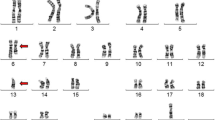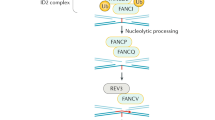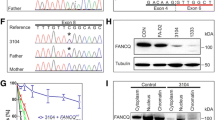Abstract
FANCONI'S anaemia (FA) is one of the genetic syndromes in which chromosomal instability has been associated with an increased predisposition to cancer1. An increased risk of malignancy has also been reported for presumptive carriers of the FA gene2,3, although no evidence of chromosome abnormalities has been found in cultured lymphocytes or fibroblasts from the FA heterozygote. The nature of the genetic defect in FA is still unclear, although there is evidence for defective DNA repair4–6.Lymphocytes from FA homozygotes have an increased incidence of chromosome aberrations after exposure to ionising radiation7 or alkylating agents8,9. We reported recently that baseline breakage rates for FA cell strains varied from 0.20 to 0.36 breaks per cell, and that after carcinogen treatment of the type described below, these rates were increased three to fivefold10. The same carcinogen treatment had no clastogenic effect on normal, xero-derma pigmentosum and trisomy 18 fibroblasts. There is at present no way to distinguish FA heterozygous individuals from normal. The only distinction that has been reported has been an increased susceptibility to in vitro transformation by the onco-genic virus SV40 in both homozygous and heterozygous FA fibroblasts11, but similar results have been obtained with cell strains from patients with several other syndromes. As the ability to identify carriers of the FA gene would be of great benefit because of their increased cancer risk, we report here the results of experiments in which we were able to distinguish FA heterozygous cell strains from normals, after exposing the cells to the difunctional alkylating agent diepoxybutane (DEB), an active mutagen and carcinogen 12–15.
Similar content being viewed by others
References
German, J. Prog. med. Genet. 8, 61–101 (1972).
Swift, M. Nature 230, 370–373 (1971).
Swift, M., Cohen, J. & Pinkham, R. Am. J. hum. Genet. 26, 304–317 (1974).
Poon, P. K., O'Brien, R. L. & Parker, J. W. Nature 250, 223–225 (1974).
Latt, S. A., Stetten, G., Juergens, L. A., Buchanan, G. R. & Gerald, P. S. Proc. natn. Acad. Sci. U.S.A. 72, 4066–4070 (1975).
Remsen, J. F. & Cerutti, P. A. Proc. natn. Acad. Sci. U.S.A. 73, 2419–2423 (1976).
Higarashi, M. & Conen, P. E. Blood 38, 336–342 (1971).
Schuler, D., Kiss, A. & Fabian, F. Humangenetik 7, 314–332 (1969).
Sasaki, M. S. & Tonomura, A. Cancer Res. 33, 1829–1836 (1973).
Auerbach, A. D. & Wolman, S. R. Nature 261, 494–496 (1976).
Todaro, G. J., Green, H. & Swift, M. R. Science 153, 1252–1254 (1966).
Kolmark, G. & Westergaard, M. Hereditas 39, 209–224 (1953).
Bird, M. J. & Fahmy, O. G. Proc. R. Soc. B 140, 556–578 (1953).
Van Duuren, B. L. Ann. N.Y. Acad. Sci. 163, 633–651 (1969).
Wolman, S. R. & Sivak, A. Lab. Invest. 33, 670–677 (1975).
Sasaki, M. S. Mutat. Res. 20, 291–293 (1973).
Stich, H. F., Stich, W. & San, R. H. C. Proc. Soc. exp. Biol. Med. 142, 1141–1144 (1973).
Author information
Authors and Affiliations
Rights and permissions
About this article
Cite this article
AUERBACH, A., WOLMAN, S. Carcinogen-induced chromosome breakage in Fanconi's anaemia heterozygous cells. Nature 271, 69–71 (1978). https://doi.org/10.1038/271069a0
Received:
Accepted:
Published:
Issue Date:
DOI: https://doi.org/10.1038/271069a0
- Springer Nature Limited
This article is cited by
-
Differential diagnosis of Fanconi anemia by nitrogen mustard and diepoxybutane
Annals of Hematology (2003)
-
Response to X-Irradiation of Fanconi Anemia Homozygous and Heterozygous Cells Assessed by the Single-Cell Gel Electrophoresis (Comet) Assay
Laboratory Investigation (2001)





